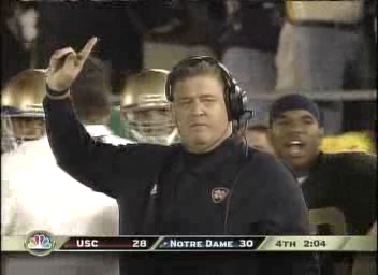Three Minutes of 2005 - Preamble
 It was a beautiful, sunny fall day when the opening kickoff was sent tumbling skyward, but the sun had long since receded below the horizon. It was night now, and the hallowed ground of the house Rockne built was illuminated only by the stadium's lights. 80,000 bewildered, hoarse, and by this time almost completely sobered-up fans stared nervously at the field as the Irish special teams unit trotted out to field the ball for what likely would be their last possession of the game. Standing next to me in section 6, the Irish Outisder caught my nervous gaze.
It was a beautiful, sunny fall day when the opening kickoff was sent tumbling skyward, but the sun had long since receded below the horizon. It was night now, and the hallowed ground of the house Rockne built was illuminated only by the stadium's lights. 80,000 bewildered, hoarse, and by this time almost completely sobered-up fans stared nervously at the field as the Irish special teams unit trotted out to field the ball for what likely would be their last possession of the game. Standing next to me in section 6, the Irish Outisder caught my nervous gaze.
"It makes sense. We need to score 31, it's the only way."
He was right. In Notre Dame's last two victories against the #1 team in the country, they had put up that exact number of points. And here we stood, five minutes left in the game, down 28-24, with one last chance to score a touchdown to reach the mythical 31.
Ambrose Wooden, a cornerback I never remember seeing returning kicks, fields the ball six yards deep in the end zone with his momentum carring him backward. He hesitates, then brings it out, only to be swallowed up by a wall of Southern Call defenders just outside of the 10 yard line. 87 yards from the goal line, things are suddenly looking bleak.
And that's how the stage was set for the greatest three minutes of Notre Dame football I have seen in my (admittedly short) adult life. 5:04 on the clock. 87 yards from the end zone, trailing the back-to-back defending national champions and media-proclaimed "greatest team in history" by four. And just for good measure, add in two Heisman trophy winners in their backfield and one of the best rivalries in college football.
Charlie Weis, the prodigious play-caller and offensive mastermind. Pete Carroll, the widely-respected defensive genius-turned-best head coach in college football. Ball spotted, whistle blown. The chess match begins.
It took eight plays - four passes followed by four runs - and three minutes for the Irish to drive the length of the field and punch it in for the go-ahead touchdown. Watching Weis put together that drive was like watching a Renaissance master paint or a symphonist playing his instrument: the intricate beauty of a master perfecting his craft.
While the end result was spoiled due to a string of highly improbable and sloppy plays strung together, I still think that this drive deserves some commemoration for the fantastic spectacle that it was. In the next two posts, I will go play-by-play through this drive, starting with the four consecutive pass plays, followed by the four runs to cap off the drive.


<< Home